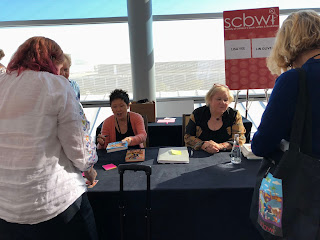 |
| Sangeeta Mehta |
Sangeeta Mehta was an acquiring editor at Little, Brown Books for Young Readers and Simon Pulse before starting her own editorial services company, which focuses on middle grade and young adult fiction. She has written several articles about self-publishing for Jane Friedman Media, including “The Business of Self-Publishing Children’s Picture Books,” “Shepherding a Self-Published Picture Book to Success,” and “Should Children’s Book Authors Self-Publish?” A Member-at-Large of the Editorial Freelancers Association, Sangeeta founded the organization’s Diversity Initiative. She also serves on the board of The Word, a nonprofit working to build a more inclusive publishing community. Follow her on Twitter @sangeeta_editor or visit www.mehtabookeditingnewyork.com.
**
Sangeeta starts out by sharing self-publishing success stories, how to determine your publishing goal, answers the question/offers us the mantra "What would a traditional publisher do?", shares resources, and fields questions from the attendees.
Success stories:
Edgar Allen Poe and Virginia Woolf and Beatrix Potter who took matters into their own hands.
More recent examples of break-out self publishing success include
The Martian by Andy Weir,
Still Alice by Lisa Genova,
Milk and Honey by Rupi Kaur.
In children's books,
Amanda Hocking's
Watersong
Beth Reekles'
The Kissing Booth (published as a teenager on Wattpad and won an award there.)
Christopher Paolini's Eragon
Carl-Johan Forssén Ehrlin's
The Rabbit Who Wants To Fall Asleep
John and Jennifer Churchman's
The SheepOver
She cautions that it's very hard to make it the way these authors have. One of the ways to help make it happen for you is to figure out your self-publishing goal.
Some of the goals for self-publishing Sangeeta shares that we might consider:
-to hone your craft
-to be part of a writing community
-undertake a project that may or may not be lucrative
-create a family keepsake
-become an entrepreneur or leverage your position as an entrepreneur
- promote your backlist
- get "discovered"
Sangeeta shares about WattPad, InkedVoices (an online critique forum), and cites Beth Revis and Cassandra Claire as examples of hybrid authors, who do both traditional publishing and self-publishing.
The heart of the session is this:
If you have a traditional deal, it's the editor who is the center of everything. If you're self-publishing, YOU'RE the center of everything.
She breaks down what the different departments at a traditional publisher do, including the:
editorial department (developmental edits, etc...)
managing editorial department (scheduling everything, copyediting, proofreading, etc...)
design department (interior and cover, etc...)
contracts department (consider if you're hiring professionals i.e,, an illustrator, etc...)
marketing department (including setting publication date, price, advanced reader copies, trades shows, etc...)
publicity department (submit book for review and award consideration, etc.... Shout out to
SCBWI's Spark Award for books published in non-traditional ways.)
Hot tip: Pitch articles that tie into your book but aren't necessarily about your book.
subsidiary rights department sells or licenses your book (foreign, translation, audio, etc...)
sales departments (gets your book into bookstores, etc...)
Where to focus first when all this responsibility is on you? Sangeeta suggests we focus on our goals, and let those guide us.
She shares lots of resources, talks about the value of paying for a Kirkus review, being the local hero where you live, shares checklists, discusses how much to invest in your book, "series potential," and so much more!
A few articles Sangeeta recommends:
Check out this article Sangeeta wrote where she interviewed Zetta Elliott, Brent Hartinger, Cheryl Klein, and Stephen Mooser about their experiences and advice self-publishing children's books.
And this article on Reedsy,
How much does self publishing really cost?
(Another resource for authors self-publishing is the nonprofit Independent Book Publishers Association.)


















































